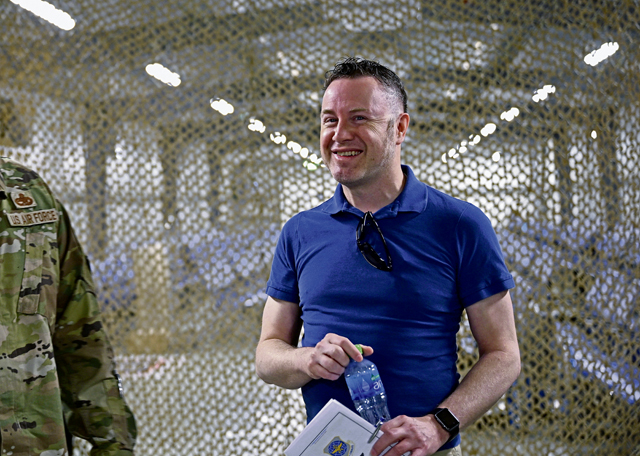
On Oct. 31, 2021, the 521st Air Mobility Operations Wing concluded the end of a significant historical chapter: the last Afghan evacuees depart Ramstein Air Base.
While some 521st AMOW locations and Airmen continued to support further evacuation efforts, the surge had ended.
But the work was just beginning for Dr. Andrew Wackerfuss, 521st AMOW historian.
Wackerfuss would spend the next six months conducting interviews, collecting data, archiving email and group chat traffic, establishing a chronology and, ultimately, writing the official history of the 521st AMOW support to the largest non-combatant airlift evacuation in U.S. history.
Wackerfuss collected interviews from 65 members totaling thousands of minutes of first-hand, ground truth perspectives on the operation.
In April, Wackerfuss proudly submitted his 74-page chapter encompassing the wing’s efforts starting in the spring of 2021 with the Afghanistan Retrograde through Operation ALLIES WELCOME.
The chapter from the 521st AMOW was compiled with inputs from Wackerfuss’ colleagues across the U.S. Air Force Expeditionary Center and Air Mobility Command enterprise.
The collective team of AMC historians won the 2021 Excellence in Wartime or Contingency History Award, and the USAF EC won the 2021 Excellence in History Program Award for the numbered Air Force, Center, or Laboratory Level.
The AMC study was submitted to the Air Force History and Museums Program to form the backbone of the entire USAF official history.
“Normally we Air Force historians spend a lot of time in the trenches documenting our units’ activities and these form our internal archives, but rarely does it become a product of this scale,” Wackerfuss said. “As a program I think this is something we can be really proud of.”
The official history cements the command’s accomplishments.
“For air mobility it was a success story. It was a big hero moment,” he said. “We got 124,000 people airlifted out of a single location in two weeks. It’s unheard of. When faced with that challenge, we crushed it. It’s nice, with a little bit of distance and perspective to tell that story and hopefully get people to realize that what the Airmen did on the ground and in the air those two weeks was absolutely heroic.”
Wackerfuss was deployed to U.S. Air Forces Central, Shaw Air Force Base, South Carolina, when the evacuation began. As the 521st AMOW’s role became ever more apparent, USAFCENT and AMC cleared him to return to Ramstein.
“It was killing me not to be here with everyone,” he said.
He quickly completed a return trip home and jumped right into the action.
Wackerfuss immediately identified key players who were able to catch him up on the events specific to the wing up to that point.
“You have to find the people who are going to be able to tell you beyond the documents what is going on. A core part of the historian’s job is collecting documents, but documents will never tell you the full story of what it was like as a person to perform this operation,” he said. “It was really fulfilling and really emotional to do these interviews. I always tried to be respectful of that and show to them how appreciative I was of their openness to share their stories.”
Wackerfuss’ timely return was critical to retain and organize the heavy influx of information circulating during the operation and his work in the months afterwards captured the human-side of the story and provided a cathartic outlet for those involved.
“Everyone was so focused on the core mission of getting people out, moving people around, caring for them, and providing for them that they didn’t have time to document… it was just go, go, go,” Wackerfuss said. “Having a historian on staff gives you a dedicated person whose job it is to do that, undistracted, it’s not an additional duty, it is their core function. If you don’t have that you will literally never know what happened.”
Wackerfuss has been with the 521st AMOW since November 2018. During his time in the wing, he has documented other historic events including the unit’s role in keeping the global air mobility support system moving during the onset and height of the Coronavirus Pandemic, the first operational uses of the Transport Isolation System and Negatively Pressurized Conex, the Afghanistan Retrograde, Operation FLY FORMULA, and ongoing support to Ukraine.
“Dr. Wackerfuss answered the call,” said Col. Dan Cooley, 521st AMOW commander. “When you have a winning team like the 521st AMOW, the value the historian brings is unmatched. His diligent efforts preserve corporate knowledge to tell the full story of our victories and improve upon them.”
Prior to joining the 521st AMOW, Wackerfuss served as an Air Force historian for nearly 12 years in four different positions including the Historical Support Office, Joint Base Anacostia-Bolling, Washington, D.C.; the 436th Airlift Wing, Dover Air Force Base, Delaware; and Headquarters Air National Guard, Joint Base Andrews, Maryland. His academic background is in German history which motivated him to find an opportunity to serve in Europe.
“It’s a fascinating mission,” Wackerfuss said about the 521st AMOW. “It really has been everything I hoped it would be, both personally to have the opportunity to live here again, but also it’s really fulfilling to be back at the wing level of operational history to really be connected to the mission as it progresses day to day and the ground experiences of the Airmen who carry it out.”
Military history provides the foundation for training, education, esprit de corps, and decision-making. The Air Force historian corps conducts and manages history programs across the full range of military operations in peacetime and war to improve warfighter capabilities. By collecting, preserving, and interpreting the institutional memory of the Air Force, the historian corps provides commanders and decision makers an informed perspective based on accurate and factual information. This applied history approach leverages the lessons of the past to create usable knowledge that informs decisions today and the future.


